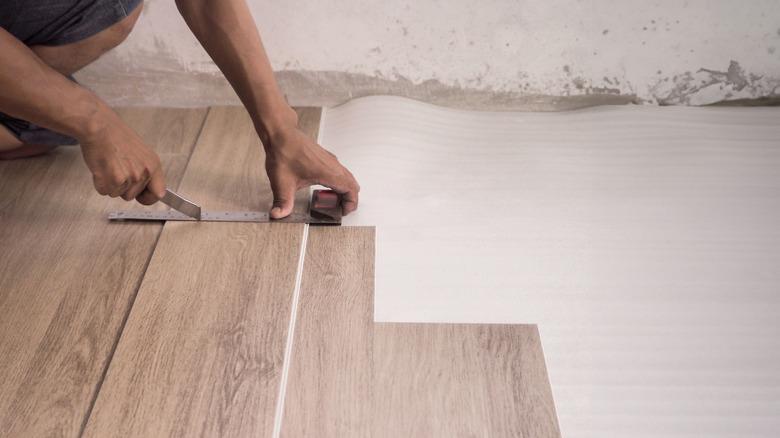The Toxic Problem With Vinyl Flooring That Nobody Warned You About
All of us want our homes to be a safe haven and an environment that is both physically and emotionally healthy. Sometimes the materials used to construct our homes threaten our safety with health-harming chemicals. That is the case with some vinyl flooring products that may already be in your home.
Vinyl flooring is made from a version of polyvinyl chloride (PVC), a common chemical in the construction world. According to the Ecology Center organization, side effects of these toxins include asthma, respiratory problems, and hormonal disruptions. To understand how the threat works, you'll need to learn two terms: off-gassing and VOCs. Off-gassing describes the release of noxious gases from seemingly inert objects such as building materials. VOCs stand for volatile organic compounds, and they are the dangerous toxins that are released into the air via off-gassing. Most people notice them in the form of pungent and irritating odors.
The harmful VOC most associated with vinyl flooring is from butyl benzyl phthalate, a chemical that helped the typical vinyl floor sheet be more flexible or rubbery (a plasticizer). A 2021 study from the Healthcare academic journal identified it as a dangerous toxin, which encouraged major brands to pledge to stop using it. In recent years, many major manufacturers have replaced benzyl butyl phthalate with a different type of plasticizer called dioctyl terephthalate (DOTP). This is a safer chemical without any immediate or acute toxicity problems found. If you have older vinyl flooring, you might still have an issue, however.
So, is new vinyl flooring safe now?
Are vinyl floors safe? For the most part, yes — newly manufactured vinyl flooring is much safer than it used to be. One caveat is that recycled vinyl flooring could be made from old flooring containing butyl benzyl phthalate. It's ironic that by trying to save the planet, you might possibly put yourself at risk. Another place where more toxic VOCs or PVC may be introduced via vinyl flooring installation is in the adhesives used to stick it to the floor and the substrate that goes under it, like MDF or medium-density fiberboard. Most sheet flooring requires the adhesive.
The ridged "plank" type of vinyl flooring, sometimes called luxury vinyl plank flooring or LVP, has always needed less of any plasticizer. But now with butyl benzyl phthalate removed from many major floor manufacturing brands, it has even fewer VOC emissions. Any possible VOCs with luxury vinyl plank flooring come mainly from the additional components used in its construction. Those with a wood polymer core have slightly higher VOCs.
The good news is that the industry has noted consumers' concerns about VOCs and PVC and has made their manufacturing change to safer methods. You can even find LVP flooring identified as a low-VOC product, something a savvy consumer can seek out. But please note that all manufactured floor coverings — carpet, LVP, the underlayment, foam pads, and adhesives will off-gas VOCs. Of course, other types of flooring like ceramic tile, the best wood flooring, and stone or marble flooring have no VOCs. If you're sensitive to VOC odors, these are the best flooring products to choose from.

